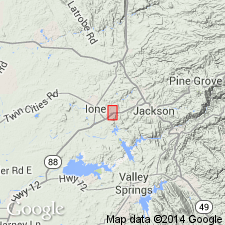
- Usage in publication:
-
- Sunnybrook volcanics*
- Modifications:
-
- Named
- Dominant lithology:
-
- Tuff
- Schist
- AAPG geologic province:
-
- Sierra Nevada province
Summary:
Pg. 51, 52, 53, pl. 7. Series of schists and greenstone in Newton copper mine area (near Jackson, Amador County, California) tentatively correlated with the Jurassic Amador group described by Taliaferro, 1942 (GSA Bull., v. 53, no. 1), is subdivided into 4 formations (descending) Mountain Spring volcanics, Dufrene slate, Newton Mine volcanics, and Sunnybrook volcanics (all new). The Sunnybrook, a sequence of undetermined thickness, consists dominantly of gray felsic rocks, including bedded feldspathic tuff and felsitic quartz-bearing tuff of rhyolite composition; within felsitic rocks is zone, approximately 400 feet thick, of dark-green chlorite-uralite schist, probably derived from pyroclastics. Thickness at least 1,500 feet thick. Measured section, along Mountain Spring Creek from Mariposa slate eastward, dips steeply to east; relation of beds to Mariposa slate suggests section is overturned, and is on west limb of an overturned anticline or its faulted equivalent. Underlies Newton Mine volcanics. Age is Jurassic, based on tentative assignment to Amador(?) group. Mapped in eastern part of Newton mine area (scale 1:400), metarhyolite tuff and chlorite-uralite schist shown separately.
Named from Sunnybrook Crossing in eastern part of Newton mine area. [Exposures of undetermined thickness occur 0.5 mi northwest[?] of Newton mine (6 mi west of Jackson, Sutter Creek 15-min quadrangle, Amador Co., east-central CA). No type section or measured section because of paucity of outcrops.]
Source: US geologic names lexicon (USGS Bull. 1200, p. 3774); GNU records (USGS DDS-6; Menlo GNULEX).
For more information, please contact Nancy Stamm, Geologic Names Committee Secretary.
Asterisk (*) indicates published by U.S. Geological Survey authors.
"No current usage" (†) implies that a name has been abandoned or has fallen into disuse. Former usage and, if known, replacement name given in parentheses ( ).
Slash (/) indicates name conflicts with nomenclatural guidelines (CSN, 1933; ACSN, 1961, 1970; NACSN, 1983, 2005, 2021). May be explained within brackets ([ ]).

